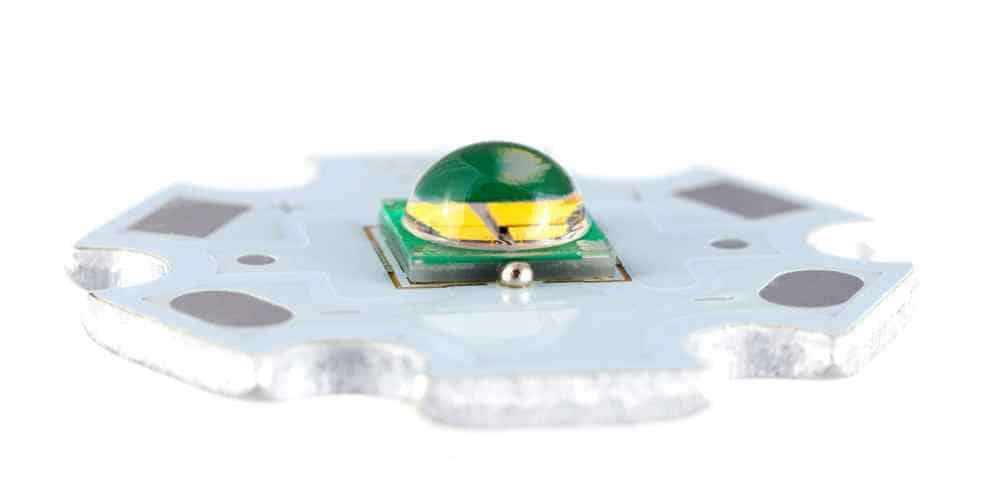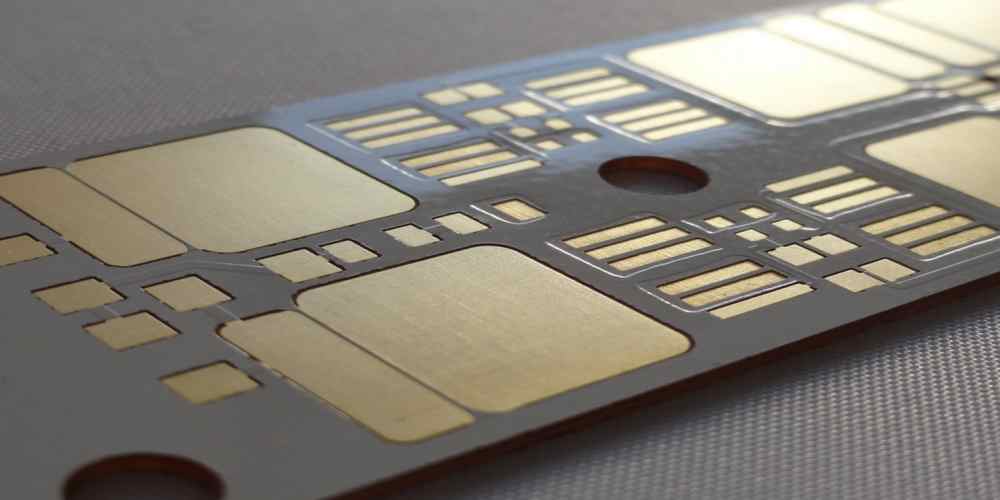An insulated metal substrate is a type of Printed Circuit Board (PCB) made with a metallic support plate or a metallic material. The material or plate is integrated or added as the thick base or inner layer of the circuit board. The primary reason for the integration is for the material to enhance both the thermal and mechanical properties of the circuit board.
Aluminum is the most popular type of material used for the integration. Also, you must note that the insulated metal substrate is separated from the copper conductors of the circuit board, with the help of a dielectric layer.

What Makes up the Insulated Metal Substrate?
As mentioned in the second paragraph above, aluminum is the most-used material for the substrate. However, other options like stainless steel and copper also exist. It is also possible to use other employed materials that provide the needed features, such as a broad spectre of thermal conductivity and higher mechanical stabilities.
The point is that despite the types of materials used for the substrate, they need to be separated from the total panel. This will bolster the heat conduction capabilities of the board.
How Insulated Metal Substrates became Popular
In today’s electronics market, innovation is the driving factor. If there is no innovation in place, you can be sure that things wouldn’t work out as expected.
Thus, the motivating factor behind the insulated metal substrate is the need to solve some of the existing issues. These challenges bothered on the inability to attain the highest levels of heat or thermal energy conduction on conventional circuit boards.
The following are some of the reasons suggesting why insulated metal substrate became as popular as ever.
The Need for Greater Dielectric Strength
It doesn’t make sense for a Printed Circuit Board (PCB) to meet up with other demands, but not have a higher dielectric strength. This is why the insulated metal substrate was introduced and has since gained a considerable adoption due to the greater or higher dielectric strength, especially when used in high-voltage applications.
Heat Dissipation Capabilities
With the demands for more-functional applications and electronic devices, the demands have also grown for the heat dissipation capabilities of such devices. The point is that if these devices are to operate at the expected (optimum) capacities, they ought to be able to dissipate, get rid of or conduct away the excess thermal energy generated in the process.
With a variety of heat dissipation processes, insulated metal substrate helps to dissipate heat from electronic modules and by so doing, help to improve the functionalities of such modules.
Understanding the Structure of the Insulated Metal Substrate
The structure or stack-up of this substrate can also help you gain clarity on how it works. The structure typically includes the circuit layer, the heat conducting layer and the dielectric layer.
First, the circuit layer refers to the like of a copper foil. The dielectric layer can either be a ceramic or a polymer. For the conducting layer, it refers to the core material that conducts or literally “drives away” heat from the circuit.
Now, let us go deeper into how all these come together to boost the heat conduction properties of the insulated metal substrate.
The circuit layer, the copper foil, is commonly used above the circuit to protect it. Inside the circuit, we have the heat and the thermally-conductive particles.
The dielectric layer, which helps to form these particles, are the polymer or ceramic. They perform a wide range of purpose, such as bonding the circuit layer (copper) and the conducting layer (aluminum). The dielectric layer also performs the following functions:
- Used for insulation purposes and;
- Serving as a medium of thermal conduction
The aluminum substrates are mostly preferred for conducting heat away from the board due to the improved machinability.
Differences between Insulating Metal Substrate’s Thermal Conductivity and Thermal Diffusivity

You may have come across those two terms, but not sure of what makes them different. You must not confuse the thermal conductivity of the insulated metal substrate for its thermal diffusivity. The difference is that while the conductivity focuses on how heat or thermal energy is conducted away or removed from the board, the diffusivity refers to the speed with which a change in the temperature can impact the heat dissipation process.
The rule of thumb is to be specific about the type of material to use for heat conduction. Just as aluminum has become a standard, you can go for the alternatives, such as stainless steel and copper.
Even at that, make sure that the thermal impedance of the material is considered as well. The impedance is a metric used to adjudge the possible internal thermal resistance of the heat-conducting material against a possible heat flow.
The Types of Insulating Metal Substrates for PCBs
There are up to five (5) types or categories of the insulated metal substrates. They all have unique features, as you can see below:
1. Single-Sided Insulated Metal Substrate PCB
As the name suggests, this type of IMS PCB uses only one side, whereby the trace prints or components are mounted on one side.
Although it allows the placement of the components on one side, there are other features of the single-sided insulated metal substrate, thus:
- It has a non-conducting solder mask.
- The single-sided IMS PCB has the metal substrate located at the bottom side.
- It also has a couple of layers, such as copper circuit layer and dielectric layer.
- The metal substrate serves as the heatsink.
- The metal base contains both aluminum and alloy.
2. Double-Sided IMS PCB
This is the opposite of the single-sided insulated metal substrate, in the sense that both sides are used. The double-sided insulated metal substrate circuit board comprises two solder masks (trace prints), which are populated or located on both sides of the circuit board.
The following makes up the structure of the double-sided insulated metal substrate circuit board:
- The base material is made of any of the following: iron alloy, copper or aluminum.
- The metal substrate is located in the middle.
- The insulation of the current-carrying vias is up to the resin material, which is applied around the vias.
- Double-sided IMS PCBs have a via, which is used to facilitate the conduction or transfer of current and heat.
3. Multilayered Insulate Metal Substrate PCBs
This is one of the most complex forms of the insulated metal substrate circuit board. In addition to the complex, it requires multiple layers for the configuration.
Here are some of the attributes of the multilayered insulate metal substrate circuit boards:
- Multiple or several copper layers are sandwiched or joined at the bottom and top sides of the substrate.
- Examples of the materials used for the multilayered IMS PCB are iron alloy, copper and aluminum. Those are mostly used for the base layer.
- It supports more component usage, as well as enables the dual-side mounting of components.
The major downside to working with a multilayered insulated metal substrate circuit board is that design is quite complex. This can be attributed to the overall support for complex circuit board designs, such as the Single-Board Computers (SBCs).
However, it makes use for that complexity with the delegation of the metalcore to act as a heat conductor for facilitating the speed of circulating heat away from the board.
4. Aluminum IMS PCBs
This is a type of insulated metal substrate circuit board that has aluminum as the primary material. The properties include moderate electrical properties and thermal conductivity capabilities.
5. Copper Metal IMS PCBs
These have copper as the substrate material. The capabilities include excellent electrical conductivity and thermal conductivity.
As much as copper insulated metal substrate circuit boards can be delegated for a wide range of applications, they have one major downside. They are quite expensive and sometimes, can be overly-exposed to faster corrosion.
6. Stainless Steel Insulated Metal Substrates
These are one of the materials used for IMS PCB designs. The upsides to stainless steel material-usage for these circuit boards are affordability and improved mechanical strength.
However, you will find out that the material, when compared to the likes of copper and aluminum, doesn’t measure up, in terms of electrical and thermal performance.
Typical Applications for Insulated Metal Substrate PCBs

The following are some of the common applications that rely on insulated metal substrates:
- Solid State Relays: also called the SSRs, they are the modernized versions of mechanical relays. Insulated metal substrates are used here to capture and transfer heat from all the components to the enclosure.
- Consumer Electronics: insulated metal substrate is used to facilitate heat conduction in consumer electronics, such as equalizers, motor and voltage regulators, as well as amplifiers.
- Automotive Applications: insulated metal substrates are used to bolster the mechanical properties and thermal conductivity capabilities of the Control Units (CUs) used in automotive applications/devices.
- LED: the Light-Emitting Diode (LED) products also benefit from the usage of the insulated metal substrates. It is because of the excessive heat produced by these products that enable the interference of the insulated metal substrates to absorb the thermal energy and transfer the same to the designated heatsink.
Conclusion
Insulated metal substrates, also called IMS PCBs, help to absorb and conduct away (excessive) thermal energy/heat from different electronic devices. Hillman Curtis makes professional recommendations on how best to optimize these substrates for the best results, across different industries. Contact us today!

